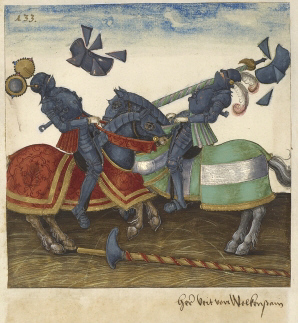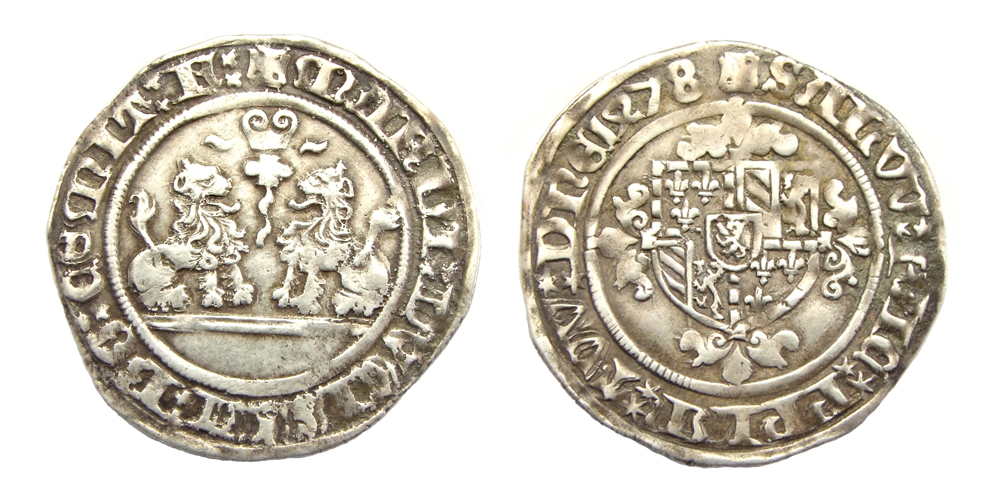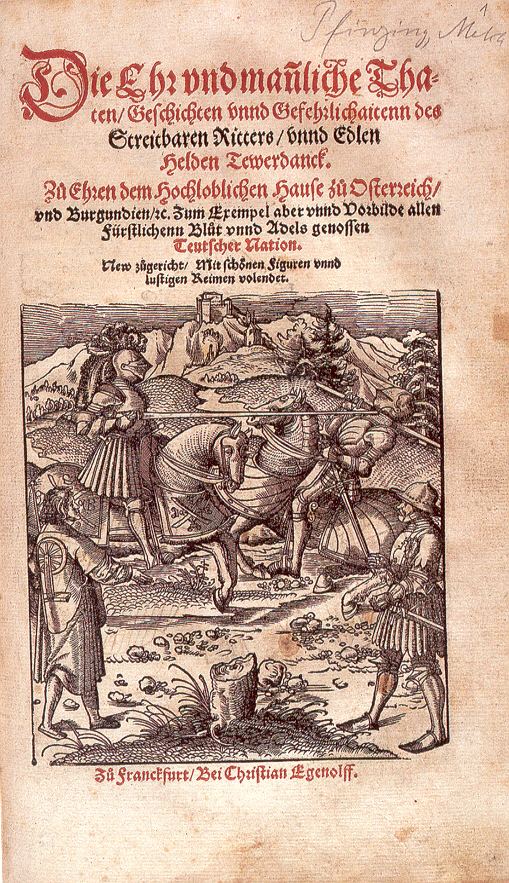|
Freydal
''Freydal'' is an uncompleted illustrated prose narrative commissioned by the Holy Roman Emperor, Maximilian I in the early 16th century. It was intended to be a romantic allegorical account of Maximilian's own participation in a series of jousting tournaments in the guise of the tale's eponymous hero, Freydal. In the story, Freydal takes part in the tournaments to prove that he is worthy to marry a princess, who is a fictionalised representation of Maximilian's late wife, Mary of Burgundy. The text was never completed, although a manuscript draft is held by the Austrian National Library. Over 200 high quality drawings were created to be used as planning sketches, 203 of which are held in the National Gallery of Art in Washington, D.C. with a small number of others preserved in the British Museum and the Vatican Library. Based on these drawings, 256 miniature paintings were created by court painters, and 255 are preserved in an illuminated manuscript ‘tournament book’ held ... [...More Info...] [...Related Items...] OR: [Wikipedia] [Google] [Baidu] |
Freydal Fol133
''Freydal'' is an uncompleted illustrated prose narrative commissioned by the Holy Roman Emperor, Maximilian I in the early 16th century. It was intended to be a romantic allegorical account of Maximilian's own participation in a series of jousting tournaments in the guise of the tale's eponymous hero, Freydal. In the story, Freydal takes part in the tournaments to prove that he is worthy to marry a princess, who is a fictionalised representation of Maximilian's late wife, Mary of Burgundy. The text was never completed, although a manuscript draft is held by the Austrian National Library. Over 200 high quality drawings were created to be used as planning sketches, 203 of which are held in the National Gallery of Art in Washington, D.C. with a small number of others preserved in the British Museum and the Vatican Library. Based on these drawings, 256 miniature paintings were created by court painters, and 255 are preserved in an illuminated manuscript ‘tournament book’ held ... [...More Info...] [...Related Items...] OR: [Wikipedia] [Google] [Baidu] |
Freydal Fol164
''Freydal'' is an uncompleted illustrated prose narrative commissioned by the Holy Roman Emperor, Maximilian I in the early 16th century. It was intended to be a romantic allegorical account of Maximilian's own participation in a series of jousting tournaments in the guise of the tale's eponymous hero, Freydal. In the story, Freydal takes part in the tournaments to prove that he is worthy to marry a princess, who is a fictionalised representation of Maximilian's late wife, Mary of Burgundy. The text was never completed, although a manuscript draft is held by the Austrian National Library. Over 200 high quality drawings were created to be used as planning sketches, 203 of which are held in the National Gallery of Art in Washington, D.C. with a small number of others preserved in the British Museum and the Vatican Library. Based on these drawings, 256 miniature paintings were created by court painters, and 255 are preserved in an illuminated manuscript ‘tournament book’ held ... [...More Info...] [...Related Items...] OR: [Wikipedia] [Google] [Baidu] |
Maximilian I, Holy Roman Emperor
Maximilian I (22 March 1459 – 12 January 1519) was King of the Romans from 1486 and Holy Roman Emperor from 1508 until his death. He was never crowned by the pope, as the journey to Rome was blocked by the Venetians. He proclaimed himself Elected Emperor in 1508 (Pope Julius II later recognized this) at Trent, thus breaking the long tradition of requiring a Papal coronation for the adoption of the Imperial title. Maximilian was the son of Frederick III, Holy Roman Emperor, and Eleanor of Portugal. Since his coronation as King of the Romans in 1486, he ran a double government, or ''Doppelregierung'' (with a separate court), with his father until Frederick's death in 1493. Maximilian expanded the influence of the House of Habsburg through war and his marriage in 1477 to Mary of Burgundy, the ruler of the Burgundian State, heir of Charles the Bold, though he also lost his family's original lands in today's Switzerland to the Swiss Confederacy. Through marriage of his son Phil ... [...More Info...] [...Related Items...] OR: [Wikipedia] [Google] [Baidu] |
Weisskunig
''Der Weisskunig'' or ''The White King'' is a chivalric novel and thinly disguised biography of the Holy Roman Emperor, Maximilian I, (1486–1519) written in German by Maximilian and his secretary between 1505 and 1516. Although not explicitly identified as such in the book, Maximilian appears as the "young" White King, with his father Frederick III represented as the "old" White King. The book is now mainly remembered for the 251 woodcut illustrations, made in Augsburg between 1514 and 1516, the principal artists for which were Hans Burgkmair and Leonhard Beck. The work was never completed, and the full published edition did not appear until 1775. Background Maximilian I, and his father Frederick III, were part of what was to become a long line of Holy Roman Emperors from the House of Habsburg. Maximilian was elected King of the Romans in 1486 and succeeded his father on his death in 1493. During his reign Maximilian commissioned a number of humanist scholars and a ... [...More Info...] [...Related Items...] OR: [Wikipedia] [Google] [Baidu] |
Tournament (medieval)
A tournament, or tourney (from Old French ''torneiement'', ''tornei''), was a chivalry, chivalrous competition or Mock combat, mock fight in the Middle Ages and Renaissance (12th to 16th centuries), and is one type of hastilude. Tournaments included melee and hand-to-hand combat (weapons were often blunted to prevent serious injury), contests of strength or History of archery, accuracy, and sometimes Jousting, jousts. Some thought that the tournaments were a threat to public order. The shows were often held because of coronations, marriages of notable figures, births, recent conquests, peace treatises, etc. They were held to welcome of people of perceived high worth, ambassadors, lords, and so on. Finally, some tournaments were held simply for pure entertainment. Such tournaments were depicted throughout the ''Codex Manesse''. Etymology Old French was in use in the 12th century, from a verb , ultimately Latin "to turn". The same word also gave rise to the Italian (modern Eng ... [...More Info...] [...Related Items...] OR: [Wikipedia] [Google] [Baidu] |
Mary Of Burgundy
Mary (french: Marie; nl, Maria; 13 February 1457 – 27 March 1482), nicknamed the Rich, was a member of the House of Valois-Burgundy who ruled a collection of states that included the duchies of Limburg, Brabant, Luxembourg, the counties of Namur, Holland, Hainaut and other territories, from 1477 until her death in 1482. As the only child of Charles the Bold, Duke of Burgundy, and his wife Isabella of Bourbon, she inherited the Burgundian lands at the age of 19 upon the death of her father in the Battle of Nancy on 5 January 1477. In order to counter the appetite of the French king Louis XI for her lands, she married Maximilian of Austria. The marriage kept large parts of the Burgundian lands from disintegration, but also changed of the dynasty from the Valois to the Habsburg (the Duchy of Burgundy itself soon became a French possession). This was a turning point in European politics, leading to a French–Habsburg rivalry that would endure for centuries. Early years Mary ... [...More Info...] [...Related Items...] OR: [Wikipedia] [Google] [Baidu] |
Masquerade Ball
A masquerade ball (or ''bal masqué'') is an event in which many participants attend in costume wearing a mask. (Compare the word "masque"—a formal written and sung court pageant.) Less formal "costume parties" may be a descendant of this tradition. A masquerade ball usually encompasses music and dancing. These nighttime events are used for entertainment and celebrations. History Masquerade balls were a feature of the Carnival season in the 15th century, and involved increasingly elaborate allegorical Royal Entries, pageants, and triumphal processions celebrating marriages and other dynastic events of late medieval court life. The "Bal des Ardents" (''"Burning Men's Ball"'') was held by Charles VI of France, and intended as a ''Bal des sauvages'' (''"Wild Men's Ball"''), a form of costumed ball (''morisco''). It took place in celebration of the marriage of a lady-in-waiting of Charles VI of France's queen in Paris on January 28, 1393. The King and five courtiers dres ... [...More Info...] [...Related Items...] OR: [Wikipedia] [Google] [Baidu] |
Theuerdank
''Theuerdank'' (''Teuerdank, Tewerdanck, Teuerdannckh'') is a poetic work composed by Maximilian I, Holy Roman Emperor, the Holy Roman Emperor, Maximilian I, (1486-1519) in German which tells the fictionalised and romanticised story of his journey to marry Mary of Burgundy in 1477. The published poem was accompanied by 118 woodcuts designed by the artists Leonhard Beck, Hans Burgkmair, Hans Leonhard Schäufelein, Hans Schäufelein and others.Bartrum, 147 Its newly designed blackletter typeface was influential. The full title in the first (1517) edition is ''Die geverlicheiten vnd einsteils der geschichten des loblichen streytparen vnd hochberümbten helds vnd ritters herr Tewrdannckhs'' ("The adventures and part of the stories of the praiseworthy, valiant and most famous hero and knight, lord Teuerdank"). Background Maximilian I, Holy Roman Emperor, Maximilian I, and his father Frederick III, Holy Roman Emperor, Frederick III, were part of what was to become a long line of Holy ... [...More Info...] [...Related Items...] OR: [Wikipedia] [Google] [Baidu] |
Albrecht Dürer
Albrecht Dürer (; ; hu, Ajtósi Adalbert; 21 May 1471 – 6 April 1528),Müller, Peter O. (1993) ''Substantiv-Derivation in Den Schriften Albrecht Dürers'', Walter de Gruyter. . sometimes spelled in English as Durer (without an umlaut) or Duerer, was a German painter, printmaker, and theorist of the German Renaissance. Born in Nuremberg, Dürer established his reputation and influence across Europe in his twenties due to his high-quality woodcut prints. He was in contact with the major Italian artists of his time, including Raphael, Giovanni Bellini, and Leonardo da Vinci, and from 1512 was patronized by Emperor Maximilian I. Dürer's vast body of work includes engravings, his preferred technique in his later prints, altarpieces, portraits and self-portraits, watercolours and books. The woodcuts series are more Gothic than the rest of his work. His well-known engravings include the three '' Meisterstiche'' (master prints) ''Knight, Death and the Devil'' (1513), '' Sain ... [...More Info...] [...Related Items...] OR: [Wikipedia] [Google] [Baidu] |
Woodcut
Woodcut is a relief printing technique in printmaking. An artist carves an image into the surface of a block of wood—typically with gouges—leaving the printing parts level with the surface while removing the non-printing parts. Areas that the artist cuts away carry no ink, while characters or images at surface level carry the ink to produce the print. The block is cut along the wood grain (unlike wood engraving, where the block is cut in the end-grain). The surface is covered with ink by rolling over the surface with an ink-covered roller (brayer), leaving ink upon the flat surface but not in the non-printing areas. Multiple colors can be printed by keying the paper to a frame around the woodblocks (using a different block for each color). The art of carving the woodcut can be called "xylography", but this is rarely used in English for images alone, although that and "xylographic" are used in connection with block books, which are small books containing text and images in t ... [...More Info...] [...Related Items...] OR: [Wikipedia] [Google] [Baidu] |
Gouache
Gouache (; ), body color, or opaque watercolor is a water-medium paint consisting of natural pigment, water, a binding agent (usually gum arabic or dextrin), and sometimes additional inert material. Gouache is designed to be opaque. Gouache has a considerable history, having been used for at least twelve centuries. It is used most consistently by commercial artists for posters, illustrations, comics, and other design work. Gouache is similar to watercolor in that it can be re-wetted and dried to a matte finish, and the paint can become infused into its paper support. It is similar to acrylic or oil paints in that it is normally used in an opaque painting style and it can form a superficial layer. Many manufacturers of watercolor paints also produce gouache, and the two can easily be used together. Description Gouache paint is similar to watercolor, but is modified to make it opaque. Just as in watercolor, the binding agent has traditionally been gum arabic but since the l ... [...More Info...] [...Related Items...] OR: [Wikipedia] [Google] [Baidu] |
German 16th Century, Freydal, The Book Of Jousts And Tournament Of Emperor Maximilian I - Combats On Horseback (Jousts)(Volume II), C
German(s) may refer to: * Germany (of or related to) **Germania (historical use) * Germans, citizens of Germany, people of German ancestry, or native speakers of the German language ** For citizens of Germany, see also German nationality law **Germanic peoples (Roman times) * German language **any of the Germanic languages * German cuisine, traditional foods of Germany People * German (given name) * German (surname) * Germán, a Spanish name Places * German (parish), Isle of Man * German, Albania, or Gërmej * German, Bulgaria * German, Iran * German, North Macedonia * German, New York, U.S. * Agios Germanos, Greece Other uses * German (mythology), a South Slavic mythological being * Germans (band), a Canadian rock band * "German" (song), a 2019 song by No Money Enterprise * ''The German'', a 2008 short film * "The Germans", an episode of ''Fawlty Towers'' * ''The German'', a nickname for Congolese rebel André Kisase Ngandu See also * Germanic (other) * Germa ... [...More Info...] [...Related Items...] OR: [Wikipedia] [Google] [Baidu] |





_von_Anhalt.jpg)





